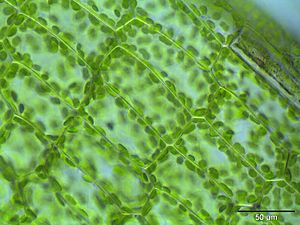Cytoplasmic streaming facts for kids

Cytoplasmic streaming is like a tiny river flowing inside living cells. It's the movement of the cytoplasm, which is the jelly-like substance filling a cell. You might also hear it called protoplasmic streaming or cyclosis.
This internal movement helps cells transport important things. Think of it as a delivery system for molecules and tiny cell parts called organelles. It's especially useful in large cells where simple diffusion (molecules spreading out on their own) would be too slow.
Contents
What is Cytoplasmic Streaming?
Cytoplasmic streaming is a fascinating process. It happens when the cytoplasm, the main material inside a cell, starts to flow. This flow isn't random; it's an organized movement. It's powered by special structures inside the cell called the cytoskeleton.
Why Do Cells Need Cytoplasmic Streaming?
Cells need to move nutrients, waste, and other important materials around quickly. In very small cells, things can move just by diffusion. This is like how a drop of food coloring spreads out in water.
However, as cells get bigger, diffusion becomes too slow. For cells larger than about 0.1 millimeters, diffusion alone isn't fast enough. Cytoplasmic streaming acts like a conveyor belt. It speeds up the transport of molecules and organelles to all parts of the cell. This makes sure the cell can work efficiently.
Where Can We See Cytoplasmic Streaming?
You can often see cytoplasmic streaming in large plant and animal cells. For example, it's very clear in the cells of some algae and in the hyphae (thread-like structures) of fungi. It's a common way for larger cells to manage their internal transport needs.
Images for kids
See also
 In Spanish: Ciclosis para niños
In Spanish: Ciclosis para niños


